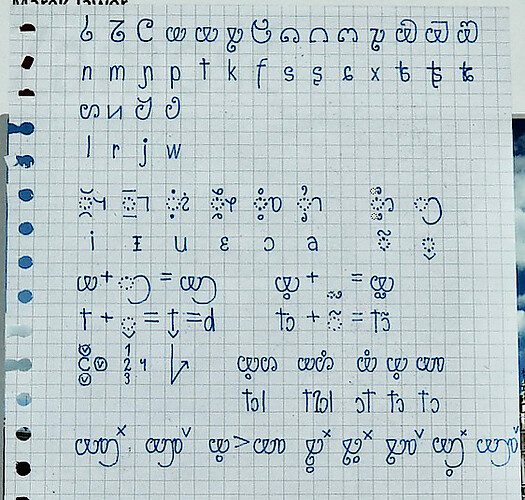Old Post
Hello, I have decided to finally show the inner workings of Krzywokreska, a writing system I have created for Polish.
Here’s a picture that shows most* of Krzywokreskas rules, ect. (click here for a (mostly) unaltered version):
I have trouble wording them, so they are shown in graphical form, but any help with putting them into sentences would be appreciated. Feel free to ask any questions.
*and about that, a rule I have no trouble wording but struggle to show it with just images can be found below.
Krzywokeskas text can be split into ‘clusters’. A ‘cluster’ usually consists of a consonant and (a) vowel(s), though often it contains just a consonant. In rare cases, when writing it that way is inevitable, the place of a consonant is left empty and only the vowel is pronounced. It is important to note that only up to 1 consonant can be in any given ‘cluster’. Also, ‘clusters’ are not the same as syllables, one ‘cluster’ can contain multiple syllables and vice versa, one syllable can stretch over multiple ‘clusters’.
Description of Krzywokreska (extremely messy and incomplete - work in progress)
(Sorry for the mess in here rn, an idea hit me like a train and it drastically changes how Krzywokreska is described)
Krzywokreska is a writing system I started making in February 2023. It consists of 26 unique characters, that meaning 18 ‘Root Letters’, 6 Vowels and 2 Diacritics. This system is what I call rn “personally phonemic”, meaning that the text is written as the creator of it heard the words. Krzywokreska also has a ‘Cluster System’, which is explained in the section below.
[‘THE SECTION BELOW’ WILL APPEAR SOON. PLEASE, BE PATIENT. THANK YOU FOR YOUR COOPERATION]
Root Letters
These letters only can occur in a clusters Root. There are 18 of them in total and they each represent a different consonant of the Polish language. They have been provisionally named: Na, Ma, Nja / Nia, Pa, Ta, Ka, Fa, Sa, Sha / Sza, Shja / Sia , Ha, Tsa / Ca, Tsha / Cza, Tshja / Cia, La, Ra, Ja, Wa / Ła.
Table of Root Letters
| Provisional Name (PN) | IPA transliteration of the PN | Krzywokreska Letter | IPA Letter |
|---|---|---|---|
| Na | na | [Temporarily Empty] | n |
| Ma | ma | [Temporarily Empty] | m |
| Nja / Nia | ɲa | [Temporarily Empty] | ɲ |
| Pa | pa | [Temporarily Empty] | p |
| Ta | ta | [Temporarily Empty] | t |
| Ka | ka | [Temporarily Empty] | k |
| Fa | fa | [Temporarily Empty] | f |
| Sa | sa | [Temporarily Empty] | s |
| Sha / Sza | ʂa | [Temporarily Empty] | ʂ |
| Shja / Sia | ɕa | [Temporarily Empty] | ɕ |
| Ha | xa (ha) | [Temporarily Empty] | x (h) |
| Tsa / Ca | t͡sa | [Temporarily Empty] | t͡s |
| Tsha / Cza | ʈ͡ʂa | [Temporarily Empty] | ʈ͡ʂ |
| Tshja / Cia | t͡ɕa | [Temporarily Empty] | t͡ɕ |
| La | la | [Temporarily Empty] | l |
| Ra | ra | [Temporarily Empty] | r |
| Ja | ja | [Temporarily Empty] | j |
| Wa / Ła | wa | [Temporarily Empty] | w |
Attachments
This category consists of two subgroups:
- Vowels - used to represent the vowel phonemes of Polish.
- Diacritics - used to modify the phonemes produced by other graphemes.
Vowels
This subgroup of attachments is made out of just 6 letters. Just as the name suggests, they are used to symbolize the 6 oral vowels of Polish. The way a vowel is written changes in relation to its position within the cluster. They have been named: I, Y, U, E, O, A.
Table of Vowels
| Name (N) | IPA transliteration of the N | Krzywokreska Letter | IPA Letter | ||
|---|---|---|---|---|---|
| Before Position | Under Position | After Position | |||
| I | i | [Temporarily Empty] | [Temporarily Empty] | [Temporarily Empty] | i |
| Y | ᵻ | [Temporarily Empty] | [Temporarily Empty] | [Temporarily Empty] | ᵻ |
| U | u | [Temporarily Empty] | [Temporarily Empty] | [Temporarily Empty] | u |
| E | ɛ | [Temporarily Empty] | [Temporarily Empty] | [Temporarily Empty] | ɛ |
| O | ɔ | [Temporarily Empty] | [Temporarily Empty] | [Temporarily Empty] | ɔ |
| A | a | [Temporarily Empty] | [Temporarily Empty] | [Temporarily Empty] | a |
Diacritics
In Krzywokreska, there are 2 of them:
- Voicer a.k.a. Voicing Diacritic - it is written attached to the Root. As the name suggests, it turns a voiceless consonant into a voiced one. Example: /t/ + Voicer = /d/
- Nasalizer a.k.a. Nasalizing Diacritic - it’s attached to a Vowel, thus being affected by the Positions as Vowels are. It changes an oral vowel into a nasal one. Example: /ɔ/ + Nasalizer = /ɔ̃/
